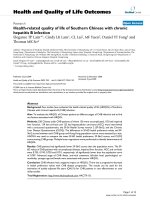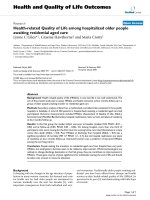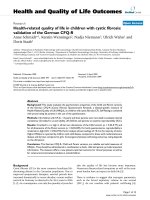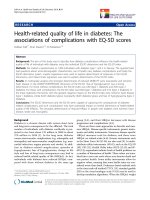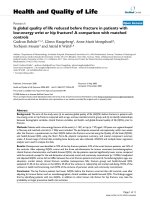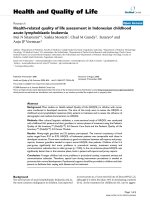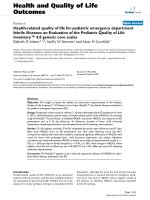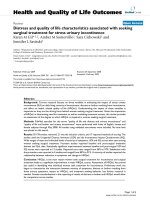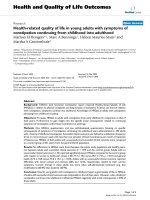báo cáo hóa học:" Factors influencing quality of life of people living with HIV in Estonia: a cross-sectional survey" pot
Bạn đang xem bản rút gọn của tài liệu. Xem và tải ngay bản đầy đủ của tài liệu tại đây (235.91 KB, 8 trang )
BioMed Central
Page 1 of 8
(page number not for citation purposes)
Journal of the International AIDS
Society
Open Access
Research
Factors influencing quality of life of people living with HIV in
Estonia: a cross-sectional survey
Kristi Rüütel*
1,2
, Heti Pisarev
2
, Helle-Mai Loit
3
and Anneli Uusküla
2
Address:
1
Department of Illegal Drug Use and Infectious Diseases Prevention, National Institute for Health Development, Tallinn, Estonia,
2
Department of Public Health, University of Tartu, Tartu, Estonia and
3
Department of Chronic Diseases, National Institute for Health
Development, Tallinn, Estonia
Email: Kristi Rüütel* - ; Heti Pisarev - ; Helle-Mai Loit - ;
Anneli Uusküla -
* Corresponding author
Abstract
Background: Identification of factors that determine quality of life is important in order to better
tailor health and social care services, and thereby improve the functioning and well being of people
living with HIV. The estimated number of people living with HIV in eastern Europe and central Asia
is 1.6 million. Little is known about the quality of life of people living with HIV in this region. The
main purpose of the present study was to identify the factors influencing quality of life in a sample
of HIV-infected persons in Estonia.
Methods: A convenient sample of 451 patients attending three infectious diseases clinics for
routine HIV clinical care visits was recruited for a cross-sectional survey. The World Health
Organization's Quality of Life HIV instrument was used to measure quality of life of the participants
and medical data was abstracted from clinical records.
Results: Good overall quality of life was reported by 42.6% (95% CI: 38.0–47.2%) of the study
participants (53% men, 60% self-identify as injecting drug users, 82% <30 years of age, 30% with
CD4+ T cell count <300 cells/mm
3
, and 22% on antiretroviral treatment). We identified the
following variables as independent predictors of good overall quality of life: being currently
employed or studying (AOR: 2.27, 95% CI: 1.18–4.38); and the absence of HIV-related symptoms
(AOR: 2.31, 95% CI: 1.24–4.29).
Conclusion: A comprehensive and competent care system, including health care providers and
social workers, is required for an effective response. In addition, social interventions should seek
to enhance the economic and employment opportunities for people living with HIV in the region.
Introduction
A patient's well being is determined not only by his or her
health status and response to treatment, but also by other
social and psychological dimensions. The identification
of factors that determine quality of life (QoL) is important
in order to better tailor health and social care services, and
thereby improve the functioning and well being of people
living with HIV (PLHIV).
In addition, the identification of potentially modifiable
factors of QoL could help target people in need of addi-
tional services in order to improve QoL [1]. Besides phys-
Published: 16 July 2009
Journal of the International AIDS Society 2009, 12:13 doi:10.1186/1758-2652-12-13
Received: 3 December 2008
Accepted: 16 July 2009
This article is available from: />© 2009 Rüütel et al; licensee BioMed Central Ltd.
This is an Open Access article distributed under the terms of the Creative Commons Attribution License ( />),
which permits unrestricted use, distribution, and reproduction in any medium, provided the original work is properly cited.
Journal of the International AIDS Society 2009, 12:13 />Page 2 of 8
(page number not for citation purposes)
ical and mental health-related factors, socio-demographic
characteristics, such as age, gender, education, income
and employment status, have been found to be strongly
associated with the QoL of PLHIV [2-4].
During the third decade of the AIDS era, new HIV epidem-
ics continue to occur. One of the most recent and rapid
increases in the number of new HIV infections in the
world has taken place in the newly independent states of
the former Soviet Union [5]. The estimated number of
PLHIV in eastern Europe and central Asia is 1.6 million
(1.2 million–2.1 million) [6]. In eastern Europe, injecting
drug users (IDUs) accounted for 62% of all newly diag-
nosed HIV cases in 2006 [7]. Little is known about the
QoL of PLHIV in this region.
The purpose of this study was to examine QoL among
Estonian HIV-infected individuals, and to assess the
impact of socio-demographic and disease-related varia-
bles on QoL in order to facilitate the development of treat-
ment and social care programmes and interventions.
Methods
Setting and sample
In 2005, a cross-sectional survey was conducted using a
convenient sample of HIV-infected patients attending for
routine clinical care visits. We recruited study subjects
from infectious diseases clinics in Tallinn, the capital of
Estonia (N = 1), and in the north-eastern Ida-Viru county
(N = 2). In total, 58% of the Estonian population live in
the capital region and in north-eastern Estonia [8]. Impor-
tantly, approximately 90% of all HIV cases in Estonia are
diagnosed in Tallinn and north-eastern Estonia [9] and,
together, these three infectious diseases clinics serve more
than 95% of all HIV-infected patients in care in Estonia
[10].
These clinics provide both in-patient and out-patient
infectious disease health care services, including HIV-spe-
cific services and antiretroviral (ARV) treatment. In each
of the three clinics, one physician was contracted for the
recruitment of study subjects, and was asked to enrol a
minimum of 150 adult HIV-positive patients from an out-
patient clinic.
Inclusion criteria for study subjects were that they be:
more than 18 years old; have the ability to read and write
in Estonian or Russian; and have been aware of their HIV-
infection status for more than three months.
After determining eligibility and securing informed con-
sent, all participants filled in the questionnaire designed
for self-administration, which required between 45 and
60 minutes to complete. Participants received supermar-
ket food vouchers to the value of approximately USD 10,
equivalent to about 100 kroon (EEK), as an incentive for
study participation.
Measurements
A self-administered survey was used for socio-demo-
graphic, HIV-related risk behaviour and QoL assessment.
Clinical characteristics were obtained from medical
records.
Specifically:
1. QoL data was collected using the World Health
Organization's Quality of Life HIV (WHOQOL-HIV)
instrument. The WHOQOL-HIV contains 29 facets,
each with four items, which are subsumed in six
domains: physical, psychological, level of independ-
ence, social, environmental and spiritual. There is also
a general facet that measures the overall QoL and gen-
eral health perceptions (overall QoL). Items are rated
on a 5-point Likert interval scale where 1 indicates
low, negative perceptions, and 5 indicates high, posi-
tive perceptions. Facet scores are the mean of the four
items in each facet. Domain scores are obtained by
adding the facet means in the respective domain,
dividing by the number of facets in that domain, and
multiplying by 4, so that scores ranged from 4 (worst
possible QoL) to 20 (best possible QoL). Adaptation
of the WHOQOL-HIV instrument to the setting and to
Estonian and Russian languages has been described
elsewhere [11]. In short, Estonian and Russian ver-
sions of the WHOQOL-HIV proved to be reliable and
valid instruments. Cronbach alpha was above 0.70 for
the six domains and the overall QoL and general
health facet. Each domain was significantly correlated
with the overall QoL and general health facet. Asymp-
tomatic people reported significantly better QoL in
physical, psychological and independence domains
and related facets compared to those people with
symptoms or AIDS [[12]; Rüütel K, unpublished data].
2. We also collected data on socio-demographic char-
acteristics (age, gender, education, marital status and
employment status) and self-identified route of HIV-
infection acquisition.
3. Physicians recruiting the patients collected clinical
characteristics from hospital records on the basis of a
standardized data abstraction form. Data on the stage
of HIV infection (no symptoms, symptoms/early HIV
disease, and AIDS), duration since diagnosis of HIV
(3–6 months, 7–12 months, 1–2 years, 3–5 years, and
more than 5 years), CD4 count, co-morbidities (hepa-
titis B and C, and tuberculosis) and antiretroviral treat-
ment were obtained.
Journal of the International AIDS Society 2009, 12:13 />Page 3 of 8
(page number not for citation purposes)
Statistical analysis
Data entry was done centrally using Microsoft Access. Sta-
tistical analysis was performed with R 2.4.0, a language
and environment software for statistical computing and
graphics. We used proportions or means with standard
deviation (for continuous data) to describe socio-demo-
graphic (age, region, gender, education and employment
status) and health-related factors (disease stage, routes of
infection, CD4 count and time since HIV diagnosis) in
different QoL groups.
For the purposes of the factors of QoL analysis, partici-
pants were divided into two groups based on the mean
score of the facet, "overall quality of life and general
health perceptions" (range 1 to 5). Participants with mean
scores of >3.0 were categorized as having good QoL, and
their counterparts (mean scores of ≤ 3.0) as having poor
QoL.
Odds ratios (OR) and 95% confidence intervals (95% CI),
together with p-values, were used to identify variables
associated with reporting good QoL. A multivariate anal-
ysis was performed using logistic regression, taking QoL
(good/poor) as the binary dependent variable and the var-
iables related to QoL in the univariate analyses as the cov-
ariates to evaluate the independent contribution of
variables to QoL.
The magnitude of the association between covariates and
QoL in univariate and multivariate analysis was evaluated
through odds ratios, together with their corresponding
95% confidence intervals. P-values of less of 0.05 were
considered as statistically significant.
Ethical approval was obtained from the Tallinn Medical
Research Ethics Committee.
Results
A total of 562 HIV-infected patients were approached for
study participation between 1 June and 31 August 2005.
Altogether, 451 (80%) were enrolled. The reasons for
non-participation were as follows: refusal (50%, 56/111),
being aware of HIV-infection status for less than three
months (37%, 41/111), and being younger than 18 years
at the time of the study (13%, 14/111). In all, 150 patients
were recruited in the capital city, Tallinn (33%) and 301
in north-eastern Estonia (67%).
Sample characteristics
Sample characteristics are presented in Table 1. The mean
age of the participants was 25 years (SD 6.9 years), and
82% (n = 371) were younger than 30 years of age. More
than half of the participants (53%, n = 240) were men.
The majority of the participants were of Russian ethnicity
(85%, n = 383); the remainder were either ethnic Estoni-
Table 1: Socio-demographic, HIV disease and co-infection
related characteristics of the participants
CHARACTERISTIC N %
Socio-demographic
Gender
Male 240 53.2
Female 210 46.6
N.A. 1 0.2
Age
≥30 years 80 17.7
<30 years 371 82.3
Place of living
Ida-Viru county, north-eastern Estonia 297 65.8
Capital city, Tallinn 132 29.3
Other 22 4.9
Ethnicity
Russian 383 84.9
Estonian 45 10.0
Other 20 4.4
N.A. 3 0.7
Education
≤9 years of formal education 180 39.9
>9 years of formal education 269 59.7
N.A. 2 0.4
Occupation
Unemployed 161 35.7
Working or studying 284 63.0
N.A. 6 1.3
Partnership
Legally married 106 23.5
Journal of the International AIDS Society 2009, 12:13 />Page 4 of 8
(page number not for citation purposes)
Other 336 74.5
N.A. 9 2.0
HIV disease related
HIV transmission category (self-report)
Injecting drug use 269 59.7
Sexual transmission 163 36.1
Other 15 3.3
N.A. 4 0.9
Time of HIV diagnosis
<12 months 87 19.3
1 to 2 years 107 23.7
≥3 years 245 54.3
N.A. 12 2.7
Stage of HIV-infection
No symptoms 268 59.4
Early HIV disease 163 36.1
AIDS 12 2.7
N.A. 8 1.8
CD4 count
≥300 cells/mm
3
240 53.2
<300 cells/mm
3
102 22.6
N.A. 109 24.2
Current ARV treatment
Yes 97 21.5
No 352 78.0
N.A. 2 0.4
Co-infections
Ever had tuberculosis
Table 1: Socio-demographic, HIV disease and co-infection
related characteristics of the participants (Continued)
ans (10%, n = 45) or representatives of other nationalities
(4.4%, n = 20). Close to two thirds (60%, n = 269) self-
reported injection drug use (sharing needles) as a poten-
tial source of HIV infection; this included 33% of the
women (n = 88) participating, and 67% of the men (n =
181). In total, 19% of the participants had been aware of
their HIV infection for less than 12 months (n = 87), 24%
for one to two years (n = 107), and 54% for more than
three years (n = 245). In terms of HIV-related health sta-
tus, 59% (n = 268) of the respondents were asympto-
matic, 36% (n = 163) symptomatic, and 3% (n = 12) had
AIDS.
Quality of life
The mean scores for the overall QoL and general health
and six domains for the sample are presented in Table 2.
In a univariate analysis, the factors which significantly
increased the likelihood of good QoL in the facet, "overall
QoL and general health perceptions", included: female
gender (48% vs 37% among males, p = 0.03); age under
Yes 10 2.2
No 439 97.4
N.A. 2 0.4
Ever had hepatitis B or C
Yes 268 59.4
No 182 40.4
N.A. 1 0.2
N.A.: Data not available
Table 1: Socio-demographic, HIV disease and co-infection
related characteristics of the participants (Continued)
Table 2: Mean scores for overall quality of life and general health
perceptions and for six domains
Mean score (SD)
Overall QoL and general health perceptions 2.9 (0.8)
Physical 13.3 (3.2)
Psychological 13.7 (2.3)
Independence 14.5 (3.2)
Social relationships 13.9 (2.6)
Environment 12.3 (2.1)
Spiritual 12.8 (2.9)
Journal of the International AIDS Society 2009, 12:13 />Page 5 of 8
(page number not for citation purposes)
Table 3: Univariate and multivariate factors associated with good quality of life among HIV-infected persons in Estonia
Characteristic Good QoL OR 95% CI p AOR 95% CI p
N%
Socio-demographic
Gender
Male 89 37.4 1.0 1.0
Female 100 47.6 1.52 1.04–2.22 0.03 0.61 0.33–1.13 0.1
Age
≥30 years 23 28.7 1.0 1.0
<30 years 166 45.0 2.03 1.20–3.43 0.009 1.55 0.74–3.25 0.2
Place of living
Ida-Viru county, north-eastern Estonia 105 35.5 1.0 1.0
Capital city, Tallinn 74 56.5 2.4 1.56–3.57 0.0001 1.08 0.62–1.88 0.8
Ethnicity
Russian 157 42.3 1.0
Estonian 24 55.8 1.7 0.91–3.25 0.09
Education
≤9 years 69 38.3 1.0
>9 years 120 44.9 1.31 0.89–1.93 0.2
Occupation
Unemployed 123 38.2 1.0 1.0
Employed and/or studying 65 52.0 3.13 2.04–4.76 <0.0001 2.27 1.18–4.38 0.01
Partnership
Other 129 38.6 1.0 1.0
Legally married 58 54.7 1.92 1.24–2.99 0.004 1.26 0.66–2.41 0.5
HIV disease related
HIV transmission category (self report)
Injecting drug use 89 37.7 1.0 1.0
Sexual transmission 86 53.4 1.89 1.27–2.86 0.002 1.37 0.73–2.59 0.3
Time of HIV diagnosis
Journal of the International AIDS Society 2009, 12:13 />Page 6 of 8
(page number not for citation purposes)
30 years (45% vs 29%, p = 0.009); living in the capital city
(57% vs 36% in Ida-Viru county, p = 0.0001); being
employed or studying (52% vs 38% among unemployed,
p < 0.0001); being legally married (55% vs 39% among
people in other types of relationships, p = 0.004); being
infected with HIV sexually, not through injecting drug
use, based on self-report on the mode of HIV acquisition
(53% vs 38%, p = 0.002); being aware of their infection
for less than 12 months (54% vs 41%, p = 0.02); having
no HIV-related symptoms, based on abstraction from
clinical records (51% vs 28%, p < 0.0001); and CD4 count
above 300 cells/mm
3
, based on abstraction from clinical
records (54% vs 32%, p = 0.0003) (Table 3).
In multivariate analysis (logistic regression model), after
including variables significant in univariate analysis into
the model, being currently employed or studying (AOR:
2.27, 95% CI: 1.18–4.38), and the absence of HIV-related
symptoms (AOR: 2.31, 95% CI: 1.24–4.29) were identi-
fied as independent predictors of good QoL (Table 3).
Discussion
This is the first study describing factors influencing QoL of
HIV-infected persons from an eastern European country,
a region that has witnessed a relatively recent HIV epi-
demic driven by injection drug use. It has been suggested
that transmission of 80% of HIV infections in former
Soviet Union countries is attributable to sharing needles
and syringes [7].
The mean overall QoL score for the whole sample (2.90 ±
0.84) was slightly lower than that reported from similar
studies from other regions. O'Connell and colleagues
have described a mean overall QoL score (measured by
WHOQOL) of 3.2 ± 0.88 for a sample of 590 HIV-infected
persons from six culturally diverse sites in Australia, Bra-
zil, India (two sites), Thailand and Zimbabwe [13].
≥12 months ago 99 40.6 1.0 1.0
<12 months ago 47 54.0 1.79 1.1–2.86 0.02 1.2 0.60–2.45 0.6
Stage of HIV-infection
Early HIV disease/AIDS 49 28.2 1.0 1.0
No symptoms 136 50.9 2.65 1.76–3.98 <0.0001 2.31 1.24–4.29 0.008
CD4 count
<300 cells/mm
3
32 31.7 1 1.0
≥300 cells/mm
3
128 53.6 2.49 1.52–4.06 0.0003 1.72 0.91–3.26 0.09
Current ARV treatment
No 136 40.2 1.0
Yes 52 48.1 1.37 0.89–2.13 0.1
Co-infections
Tuberculosis
Yes 4 40.0 1
No 184 42.1 1.09 0.3–3.92 0.9
Hepatitis B and/or C co-infection
Yes 106 39.8 1
No 83 45.6 1.27 0.86–1.85 0.2
Table 3: Univariate and multivariate factors associated with good quality of life among HIV-infected persons in Estonia (Continued)
Journal of the International AIDS Society 2009, 12:13 />Page 7 of 8
(page number not for citation purposes)
Further, we can argue that our study overestimated the
QoL of PLHIV in Estonia. Several studies have docu-
mented better physical health-related QoL among former
IDUs than in current IDUs [14,15]. IDUs often struggle
with multiple health risks due to social, economic and
psychological factors. Getting HIV care may not be their
top concern because they face other more pressing daily
challenges, such as addiction, poverty, incarceration,
homelessness, depression, mental illness and past trauma
[16].
Given this and the highly stigmatised nature of illegal
drug use, both former and current injecting drug users are
less likely to receive HIV-related medical care – this is the
case in Estonia – and hence they may be under-repre-
sented in the clinical samples of PLHIV. In our sample,
60% of participants reported having used injecting drugs.
In our study, the independent and most influential con-
tributors to the general QoL were a person's employment
status and clinician-recorded HIV-disease stage. The
employed participants, including those who were study-
ing, were more likely to have good general QoL than their
not-working counterparts. Our findings are consistent
with previous research, which has demonstrated that
employment (and higher income) is associated with a bet-
ter QOL among PLHIV [17,18].
Controlling for disease severity, employed individuals
report significantly higher level of perceived QoL than
those who are unemployed [19-21]. Besides financial
benefits, employment also provides a source for structure,
social support, role identity and meaning. In addition, sta-
ble income and employment have been associated with
adherence to highly active antiretroviral treatment [22].
Employment may also provide resources, which buffer the
effects of the stress of HIV infection and thus serves to
maintain a sense of quality of life [21]. Therefore, return-
to-work programmes and other interventions to enhance
the economic and employment opportunities are impor-
tant for PLHIV in eastern Europe and the Russian Federa-
tion. Here, young injecting drug users are the main HIV
risk group, and unemployment among them is high.
According to our results, asymptomatic patients reported
better QoL than those with symptoms or AIDS diagnosis.
This factor is amenable for clinical interventions. Quality
of life can be altered by both the immediate effects and the
longer-term consequences of antiretroviral treatment. Per-
sons with advanced HIV disease and low QoL scores have
demonstrated significant improvements in QoL with ARV
treatment [23,24].
Other disease-related factors and co-infection with hepa-
titis B or C were not associated with better QoL in our
sample. Nevertheless, given the extremely high (>90%)
hepatitis C infection rates among IDUs in the region and
the high proportion of IDUs among PLHIV [25,26], co-
infections with hepatitis B or C warrant attention. Several
previous studies have suggested that hepatitis C infection
significantly reduces health-related QoL [27,28], and this
effect can be inversed with antiviral treatment [29].
Chronic hepatitis B infection similarly negatively impacts
on QoL [30].
With improvements in HIV treatment, liver disease has
become a major cause of hospitalisation and death in
PLHIV and complications related to hepatitis B or C co-
infection are becoming an increasingly important medical
issue. Proper prevention, screening and management of
co-infections are of great concern given the high rates of
hepatitis B and C infections in Estonia.
Limitations
Our study had limitations. Given the design of the study,
we are able to demonstrate neither causality nor the direc-
tion of the described associations. The degree to which the
study is representative of the larger HIV-infected popula-
tion is influenced by the potential selective factors associ-
ated with recruiting from HIV treatment settings.
Our results most likely overestimate the QoL of those
infected with HIV, as we have discussed. We were success-
ful in recruiting people who are in HIV care in Estonia by
sampling from the facilities that provide 95% of HIV care
in the country. We also achieved a high participation rate
in a specified study period.
To decrease the potential for social desirability bias, we
used a self-administered survey instrument for risk behav-
iour data collection. To enhance the validity of the data on
health status, we complemented self-reports with clinical
data abstracted from clinical records.
Conclusion
In conclusion, HIV disease status and employment were
the important factors influencing QoL of PLHIV in Esto-
nia. A comprehensive and competent care system, includ-
ing medical staff and social workers, is required for an
effective response. In addition, social interventions
should seek to enhance the economic and employment
opportunities for PLHIV.
This data contributes to the input needed for planning
health care services and interventions that address QoL
improvement for PLHIV in eastern Europe and central
Asia.
Journal of the International AIDS Society 2009, 12:13 />Page 8 of 8
(page number not for citation purposes)
Competing interests
The content of this paper has not been published else-
where; nor is it being considered for publication else-
where. The authors declare that they have no competing
interests.
Authors' contributions
KR and HML designed the study. HML supervised the data
collection. KR, AU and HP designed the data analysis and
structure of the manuscript. HP conducted the statistical
analysis. KR wrote the first draft of the manuscript. All of
the authors contributed to the final version of the manu-
script.
Acknowledgements
This study was funded by: the Global Fund to Fight HIV, Tuberculosis and
Malaria's programme, "Scaling up the response to HIV in Estonia"; the
Embassy of the United States of America in Estonia's project, "HIV and
human rights: reducing the stigma on three levels: prevention, quality of
services and policy"; and the grant No. R01 TW006990 from the Fogarty
International Center, National Institutes of Health, USA.
The authors are grateful to the participants and the study team for their
cooperation.
References
1. McDonnell KA, Gielen AC, O'Campo P, Burke JG: Abuse, HIV sta-
tus and health-related quality of life among a sample of HIV
positive and HIV negative low income women. Quality of Life
Research 2005, 14:945-957.
2. Cowdery JE, Pesa JA: Assessing quality of life in women living
with HIV infection. AIDS Care 2002, 14(2):235-245.
3. Wachtel T, Piette J, Mor V, Stein M, Fleishman J, Carpenter C: Qual-
ity of life in persons with human immunodeficiency virus
infection: Measurement by the medical outcomes study
instrument. Ann Intern Med 1992, 116:129-137.
4. Murri R, Fantoni M, Del Borgo C, Visona R, Barracco A, Zambelli A,
Testa L, Orchi N, Tozzi V, Bosco O, Wu AW: Determinants of
health-related quality of life in HIV-infected patients. AIDS
Care 2003, 15(4):581-590.
5. Rüütel K, Uusküla A: HIV epidemic in Estonia in the third dec-
ade of AIDS era. Scandinavian Journal of Infectious Diseases 2005,
38:181-186.
6. UNAIDS/WHO: AIDS Epidemic Update. Geneva 2007.
7. EuroHIV: HIV/AIDS Surveillance in Europe. Mid-year report.
2007.
8. Database of Statistical Office of Estonia [ />rahvastik]
9. Database of Estonian Health Protection Inspectorate [http:/
/www.tervisekaitse.ee/?page=102]
10. Database of National Institute for Health Development
[ />]
11. Rüütel K, Uusküla A, Minossenko A, Loit HM: Quality of life of peo-
ple living with HIV and AIDS in Estonia. Cent Eur J Public Health.
2008, 16(3):111-115.
12. Rüütel K, Loit HM, Uusküla A: Psychometric properties of Rus-
sian version of WHOQOL-HIV instrument. The 5th European
Conference on Clinical and Social Research on AIDS and Drugs: 28–30
April 2009; Vilnius, Lithuania . Abstract no PE3.3/7.
13. WHOQOL-HIV Group: Preliminary development of the
World Health Organization's Quality of Life HIV Instrument
(WHOQOL-HIV): analysis of the pilot version. Social Science
and Medicine 2003, 57:1259-1275.
14. Preau M, Protopopescu C, Spire B, Sobel A, Dellamonica P, Moatti JP,
Carrieri MP: Health related quality of life among both current
and former injection drug users who are HIV-infected. Drug
Alcohol Depend. 2007, 86(2-3):175-182.
15. Costenbader EC, Zule WA, Coomes CM: The impact of illicit
drug use and harmful drinking on quality of life among injec-
tion drug users at high risk for hepatitis C infection. Drug Alco-
hol Depend. 2007, 89(2-3):251-258.
16. Galea S, Vlahov D: Social determinants and the health of drug
users: socioeconomic status, homelessness, and incarcera-
tion. Public Health Rep 2002, 117(Suppl 1):S135-145.
17. Blalock AC, MacDaniel JS, Farber EW: Effect of employment on
quality of life and psychological functioning in patients with
HIV/AIDS. Psychosomatics 2002, 43:400-404.
18. Worthington C, Krentz HB: Socio-economic factors and health-
related quality of life in adults living with HIV. International Jour-
nal of STD & AIDS 2005, 16(9):608-614.
19. Low-Beer S, Chan K, Wood E, Yip B, Montaner JS, O'Shaughnessy
MV, Hogg RS: Health related quality of life among persons
with HIV after the use of protease inhibitors. Quality of Life
Research 2000, 9:941-949.
20. Mrus JM, Leonard AC, Yi MS, Sherman SN, Fultz SL, Justice AC, Tse-
vat J: Health-related quality of life in veterans and nonveter-
ans with HIV/AIDS. J Gen Intern Med 2006,
21:S39-47.
21. Sowell RL, Seals BF, Moneyham L, Demi A, Cohen L, Brake S: Quality
of life in HIV-infected women in the south-eastern United
States. AIDS Care 1997, 9(5):501-512.
22. Carballo E, Cadarso-Suarez C, Carrera I, Fraga J, de la Fuente J,
Ocampo A, Ojea R, Prieto A: Assessing relationships between
health-related quality of life and adherence to antiretroviral
therapy. Quality of Life Research 2004, 13:587-599.
23. Cohen C, Revicki DA, Nabulsi A, Sarocco PW, Jiang P, the Advanced
HIV Disease Ritonavir Study Group: A randomized trial of the
effect of ritonavir in maintaining quality of life in advanced
HIV disease. AIDS 1998, 12:1495-1502.
24. Nieuwkerk PT, Gisolf EH, Reijers MHE, Lange JMA, Danner SA,
Sprangers MAG: Long-term quality of life outcomes in three
antiretroviral treatment strategies for HIV-1 infection. AIDS
2001, 15:1985-1991.
25. Tefanova V, Tallo T, Kutsar K, Priimägi L: Current trends in the
epidemiology of viral hepatitis B and C in Estonia. EpiNorth
2005, 3(6):57-61.
26. Uusküla A, McNutt LA, Dehovitz J, Fischer K, Heimer R: High prev-
alence of blood-borne virus infections and high-risk behav-
iour among injecting drug users in Tallinn, Estonia. Int J STD
AIDS 2007, 18(1):41-46.
27. Foster G, Goldin R, Thomas H: Chronic hepatitis C virus infec-
tion causes a significant reduction in quality of life. Hepatology
1998, 27:209-212.
28. Bonkovsky HL, Wooley JM: The Consensus Interferon Study
Group. Reduction of health-related quality of life in chronic
hepatitis C and improvement with interferon therapy. Hepa-
tology 1999, 29:264-210.
29. Bonkovsky HL, Snow KK, Malet PF, Back-Madruga C, Fontana RJ,
Sterling RK, Kulig CC, Di Bisceglie AM, Morgan TR, Dienstag JL,
Ghany MG, Gretch DR, HALT-C Trial Group: Health-related
quality of life in patients with chronic hepatitis C and
advanced fibrosis. J Hepatol. 2007, 46(3):420-431.
30. Herdman MJ, Ossa D, Briggs AS, Tafesse E, Iloeje U, Lozano-Ortega
G, Levy AR:
Impact on quality of life of health states induced
by chronic hepatitis B infection: estimates from uninfected
and infected persons in Spain. J Clin Virology 2006, 36(Suppl
2):S78.
